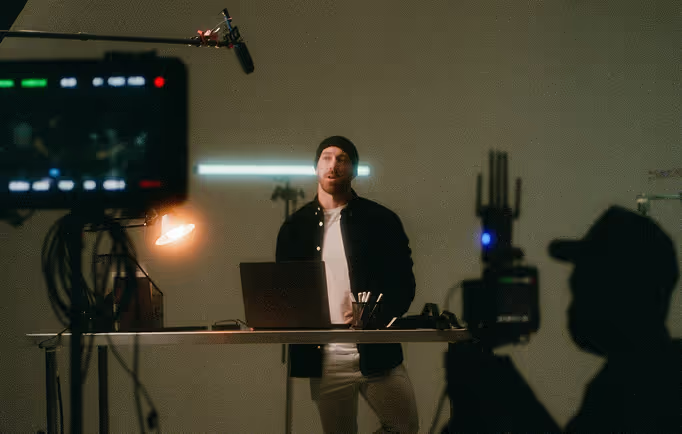Training videos your workers will actually watch

Ah yes, the corporate training video. More ridiculed than the recruitment video, and only slightly less reviled than the school project video. But little do most people know it doesn’t have to be this way. Indeed, your training videos can be eye-catching, funny, or even – dare I say – interesting. Don’t believe it? Check out our eight tips for making great animated training videos and decide for yourself.
1) be interesting. don’t be uninteresting.
Yeah, it’s as easy to say ‘be interesting’ as it is to say ‘be good-looking’. Sometimes you’re forced into a situation where that seems next to impossible. But making an interesting training video doesn’t have to involve EXPLOSIONS! GUNFIRE! SHOCKING PLOT TWISTS! (…Unless you work in the Explosions And Gunfire Factory, which would indeed be quite the plot twist.)
‘Interesting’ in the case of video production can mean simply ‘moving’. A narrator talking about health and safety policy with a page of powerpoint-style text on screen = not moving. A simple animated representation of each concept = moving. Of course if your script and narration are snappy too, that definitely adds to the interest level. And if you have a memorable video concept to link your training concepts together? Interest levels over 9000.
2) repeat yourself. in other words, repeat yourself.
Unlike some corporate videos where awareness or simple recognition are key, a training video by its very nature needs to value the viewer’s level of comprehension. Don’t be afraid to repeat important training steps during, and at the end of, the video.
Use a essay-style method to get the most efficient information across. Begin with a main point that can be summed up in a couple of words. Then, explain the main gist of that point in a sentence. Cap it off with an example or demonstration.
3) visuals > dialogue > text, but visuals + dialogue + text = winning combination
When it comes to retention of video content, images and sound have proven time and again to be more engaging than text. But the combination of all three is where we really start to hit the sweet spot. This is because different people respond to different learning styles: some of us learn by doing, some of us recall aural information best, some of us learn visually and some have a great mental recall for words. When we present an idea to an engaged audience with text, sound, and images in tandem we stimulate three input centres of the brain at once.
What’s more, we also stand a much greater chance of engaging with a passive audience – someone glancing at the video can still see the message without having to hear it, and someone looking away can still listen without watching.
4) like post-its on a hedgehog, stick to the big points
If you’ve got a particularly complex topic to cover, sub-categories are your best friends. Break your big topic up into a few smaller points. If those smaller points need elaboration, break them up into smaller points. Don’t overwhelm your audience though – separate, shorter videos to cover adjacent topics are better than one huge, unmanageable video. Questions about a particular topic can then be met with a specific link to a specific video, rather than one large video the viewer needs to scrub through to find value in.
5) demonstrate it
Unless you’re specifically creating a video for The Institute Of The Blind, a training video absolutely needs visual aids. Pictogram-style animations are popular because of their immediate association with safety signage. Cartoon-style characters are a good option for lightening and humanising workplace procedures. Technical and intangible procedures can be effectively demonstrated with motion graphics, using icons to represent abstract concepts. Whichever visual style you go for, make sure the action or intention of the point is clearly demonstrated. People who are visual learners will retain training best once having seen how it’s supposed to be done.
6) make the videos visible
Once your training video is made in all its glory, don’t tuck it away on an obscure page behind a broken link in the back catalogues of your employee resource website. Share the video, post it clearly on a dedicated page and include any notes about the application of the training content. Make it easy for your trainees, and in turn make it easy for yourself by cultivating a competent, well-trained crew.
7) in conclusion, summarise
Put your dot point skills to the test by summarising the major steps at the end of your video. If you can headline each step with one word, even better. And hey – you know that rule of three everyone bangs on about? Whip that guy out here and watch the recall results. Regardless of whether the advice stays true, it’s hard to deny the long-term memorability of ‘Slip, Slop, Slap’, ‘Stop, Drop, and Roll’ and ‘Back, Sack, and Crack’. Wait… maybe not that last one.
8) leave it to the professionals
Employing the services of a video production company to make your training videos carries multiple advantages:
A) Making your own training videos can be dangerous for your brand’s dignity. There’s nothing more cringeworthy than a HR representative being forced to sit in the break room in front of a camera and read a list of safety regulations off a piece of paper.
B) Reputable production houses are experienced and knowledgable about the way information retention works with video. They’re trained in how to use of the principles of design to shape the viewer experience, and they’re familiar with the individual needs of different types of brands/organisations.
C) Putting your training video production into someone else’s capable hands means more time actually doing what you do best, getting more out of your brand and interacting with your trainees face-to-face. …We’ll let you decide for yourself if that’s a good thing.
Start a






